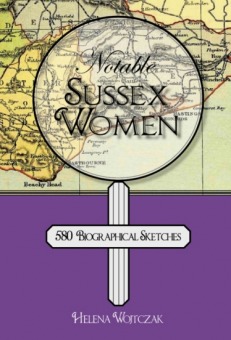
Notable Sussex Women records and commemorates the lives of 580 famous or interesting individuals who were born, lived or died in Sussex between 1700 and 2008.
One sex is habitually overlooked when inhabitants and officials of towns and counties look for eminent or otherwise interesting former residents to claim as their own. Not one woman graces the list of ‘Notable Inhabitants’ on Worthing Borough Council’s website, nor is any member of the female sex included on the list of ‘Famous ex-Residents’ on the Hastings & St Leonards Observer website. No woman’s name appears on any of the six commemorative plaques in Worthing. Arun District Council honours only one woman (and eighteen men) on its blue plaques; similarly, Eastbourne’s plaque ratio is one female to eighteen males. West Sussex County Council has erected thirty-four plaques; only one is for a woman. This pattern is repeated in county guides and similar publications.
And yet, as this book amply proves, there is no shortage of notable women connected with Sussex, women who were considered sufficiently eminent to warrant entries in the Oxford Dictionary of National Biography, to deserve obituaries in the national press, who were the subject of published biographies, whose books sold in their tens of thousands, who were household names in their day, pioneers in their field, or whose achievements were recognised with awards, medals, honours and even damehoods.
Not every woman within these pages warrants anything so grand as a blue plaque; but every one is worthy of attention for her contribution to society, the arts and sciences and the great struggle for women’s emancipation; for rebelling against the narrow destiny set for women; for their audacity in invading men’s spheres of public and professional life. In many cases these biographical sketches tell of women’s refusal to stay within the confines of ‘woman’s sphere’.
Rather than being omitted and ignored when plaques are awarded and lists compiled, it could be argued that notable members of the female sex deserve more, not less, recognition than their male counterparts for their achievements because they operated within a framework of sexual prejudice and met resistance and obstruction when stepping outside of their sphere.
